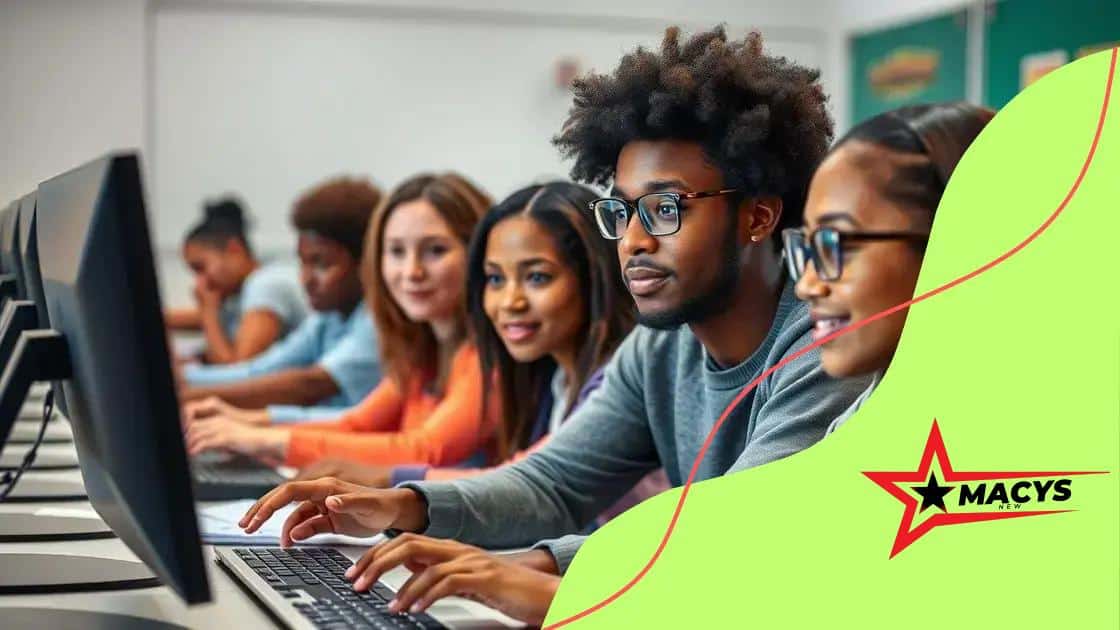Virtual labs for STEM education: transforming learning

Virtual labs for STEM education provide interactive and safe environments for students to conduct experiments, enhance understanding, and develop critical skills, integrated seamlessly into existing curricula.
Virtual labs for STEM education are reshaping how students learn complex topics in science and technology. Imagine conducting experiments in a safe, digital environment! Curious about how this works? Let’s dive in.
Overview of virtual labs in STEM
Virtual labs are changing the face of education, particularly in STEM areas. These innovative platforms allow students to conduct experiments and explore science in a controlled environment. With virtual labs, learners can engage with complex concepts without the limitations of physical materials.
What Are Virtual Labs?
Virtual labs are online simulations that enable students to perform scientific experiments. They replicate real-world lab experiences, making it easier for students to grasp the material. These tools are especially useful in science classes where hands-on experiences may be limited.
Key Features of Virtual Labs
- Interactive simulations that mimic real lab experiments.
- Accessibility from any device with internet connection.
- Instant feedback to help students understand concepts.
- Diverse range of subjects from physics to biology.
One of the best aspects of virtual labs for STEM education is their ability to provide a safe environment. Students can make mistakes without the fear of causing accidents or wasting materials. This encourages experimentation and exploration, which are fundamental to the scientific process.
Additionally, virtual labs often include tutorials and guides. These resources can help students navigate complex topics and improve their skills. By using virtual labs, educators are making it easier for students to learn at their own pace.
As the world becomes more digital, the need for effective online learning tools is greater than ever. Virtual labs are at the forefront of this movement, providing interactive and accessible learning experiences.
Benefits of using virtual labs
The benefits of using virtual labs in STEM education are numerous and impactful. These platforms not only enhance learning experiences but also make education more engaging and accessible for students of all backgrounds.
Enhanced Understanding
One major advantage of virtual labs is their ability to provide a deeper understanding of complex concepts. Through interactive simulations, students can visualize processes that are often hard to grasp through traditional teaching methods. This hands-on approach fosters active learning, allowing students to experiment and discover on their own.
Cost-Effectiveness
Virtual labs are often more cost-effective than physical labs. Maintaining a traditional laboratory can be expensive due to equipment, materials, and safety requirements. With virtual labs, institutions can save money while offering high-quality education.
- Reduction of material costs.
- No need for expensive equipment.
- Less space required for physical labs.
- Easier updates to software rather than hardware.
This cost-effectiveness opens up opportunities for more schools to implement STEM programs, thereby increasing accessibility for students who might not otherwise have such resources.
Moreover, virtual labs are accessible at any time and from anywhere, enabling students to learn at their own pace. This flexibility is particularly beneficial for those who may have additional commitments or constraints. Students can revisit experiments and concepts as needed, reinforcing their learning.
Collaboration is another benefit offered by these platforms. Virtual labs often include features that allow students to work together on projects, even from different locations. This not only enhances teamwork skills but also prepares students for collaborative work environments in their future careers.
How to implement virtual labs in classrooms

Implementing virtual labs in classrooms can transform the learning experience for students. By following a few simple steps, educators can create an engaging learning environment that promotes exploration and curiosity.
Step 1: Choose the Right Platform
The first step is to select a suitable virtual lab platform. There are many options available, each offering different features. Consider factors like subject offerings, ease of use, and cost.
Step 2: Integrate with Curriculum
After choosing a platform, it’s essential to integrate the virtual lab into the existing curriculum. Teachers should identify which lessons can benefit from hands-on simulations. This allows for a seamless transition between traditional teaching methods and the use of virtual tools.
- Align virtual experiments with class objectives.
- Utilize virtual labs for difficult or hazardous experiments.
- Encourage students to explore topics beyond the classroom.
As students engage with the virtual labs, they will have the opportunity to apply what they’ve learned in real-life scenarios. This connection enhances understanding and retention.
Training is another important factor in the successful implementation of virtual labs. Educators should familiarize themselves with the platform to guide students effectively. Many platforms provide tutorials and demo sessions that can help teachers gain confidence in using these tools.
Step 3: Encourage Collaboration
Collaboration among students can be enhanced through virtual labs. When students work on projects together in a virtual environment, they develop teamwork and communication skills. Have students share their findings and present their experiments to the class, fostering a collaborative atmosphere.
Continuous assessment is also recommended. Teachers can use quizzes and reflective discussions to evaluate understanding and improve teaching methods. Regular feedback helps students to identify areas of improvement while reinforcing their learning.
Popular virtual lab platforms
There are several popular virtual lab platforms that educators can choose from. Each platform has unique features that cater to different subjects and learning styles.
1. Labster
Labster is one of the leading platforms in virtual lab technology. It offers a wide range of interactive simulations for biology, chemistry, and physics. Students can conduct experiments that mirror real-world scenarios in a safe environment. The platform is designed to enhance critical thinking and problem-solving skills.
2. PhET Interactive Simulations
PhET is a free resource developed by the University of Colorado Boulder. It provides engaging simulations for science and math topics. The user-friendly interface allows students to explore concepts at their own pace. PhET encourages inquiry-based learning, promoting a deeper understanding of subjects.
- Diverse subject offerings, including physics and chemistry.
- Interactive and engaging user experience.
- Accessible on multiple devices, including tablets.
By using PhET, students can visualize and manipulate variables, which aids in grasping complex concepts.
3. Gizmos
Gizmos is another well-known platform offering a library of over 400 virtual labs. It covers math and science subjects and provides interactive tools for experiments. The platform includes assessments and teaching resources, making it easy for educators to track student progress.
Additionally, Gizmos fosters collaboration among students through shared projects. This feature allows them to work together on experiments and deepen their understanding through discussion and teamwork.
As virtual labs gain popularity, these platforms are paving the way for innovative learning experiences in classrooms. By embracing virtual lab technology, educators can inspire students to delve deeper into STEM subjects.
Future of virtual labs in education
The future of virtual labs in education looks promising and innovative. As technology advances, these platforms are expected to become even more integrated into the learning experience. Students can look forward to enhanced features that provide deeper and more interactive learning opportunities.
Adaptive Learning Experiences
One key aspect of the future is adaptive learning. Virtual labs will utilize advanced algorithms to tailor experiences based on individual student needs. This means that every student can work at their own pace and receive personalized feedback to enhance their understanding.
Increased Collaboration
Future virtual labs will likely promote greater collaboration among students. With features that allow for real-time interaction, students from different locations can work together on projects, fostering teamwork skills. They will be able to discuss experiments and share findings, making learning a more communal experience.
- Interactive group projects across distances.
- Sharing resources and insights via integrated platforms.
- Encouraging diverse perspectives on problem-solving.
This collaborative aspect will prepare students for future work environments where teamwork is essential.
Integration of AI and Data Analysis
Artificial Intelligence (AI) will play a significant role in the future of virtual labs. AI can help simulate experiments, analyze data, and provide insights on student performance. This integration will not only save time but also enhance the learning experience by providing valuable data for both students and educators.
Moreover, as virtual labs become more advanced, they can incorporate elements like augmented reality (AR) and virtual reality (VR). These technologies can offer immersive experiences, allowing students to explore complex scientific concepts in ways that traditional labs cannot provide.
As the landscape of education continues to evolve, the continued advancement of virtual labs will be crucial in fostering engaging and effective learning environments. Students will be better equipped to face the challenges of the future, having developed skills in technology and collaboration.
The future of virtual labs in education is bright and full of potential. By integrating advanced technology, these platforms will enhance learning experiences for students. With personalized learning, increased collaboration, and the use of AI, students can engage in science like never before. As educators embrace these changes, they will prepare students to tackle real-world challenges in STEM fields. The innovations in virtual labs are not just about technology; they are about fostering curiosity and a love for learning.
FAQ – Frequently Asked Questions about Virtual Labs in Education
What are virtual labs?
Virtual labs are online simulations that allow students to conduct experiments and explore scientific concepts in a safe and interactive environment.
How do virtual labs enhance student learning?
They provide hands-on experiences that help students grasp complex ideas better than traditional methods, promoting active learning and engagement.
Can virtual labs be integrated into existing curricula?
Yes, educators can easily align virtual labs with their lesson plans to complement and enhance their teaching.
What technologies will shape the future of virtual labs?
The future will see more integration of AI, adaptive learning, and augmented/virtual reality to provide immersive and personalized learning experiences.





